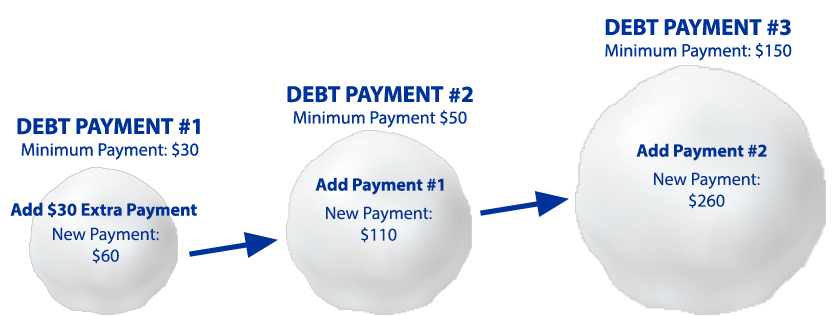Top 6 ways to get your debt under control quickly after the holidays
During the holiday season it’s all too easy to get caught up in the moment and go outside of our  budget with expensive gifts and extra activities. In fact a recent financial poll has discovered that one third of Canadians rack up an additional $1,200 in credit card debt over the holidays. If you’ve recently gone over budget on credit card debt and Holiday Cheer don’t despair, we have a way out. Here are a few tips for you to use to get your debt back under control:
budget with expensive gifts and extra activities. In fact a recent financial poll has discovered that one third of Canadians rack up an additional $1,200 in credit card debt over the holidays. If you’ve recently gone over budget on credit card debt and Holiday Cheer don’t despair, we have a way out. Here are a few tips for you to use to get your debt back under control:
1) Separate your income and expenses
The first step to getting your debt back under control is to completely assess your financial situation. Budget your income and expenses, also called a money list. You can do this by using Microsoft Excel, Word, or even just a sheet of paper.
The first step is to list out and add up all of your sources of monthly income. Once you’ve completed this, try to list and add up all of your monthly expenses, and I mean EVERYTHING. Include all of your expenses from your bi-weekly or monthly mortgage to your morning cup of coffee out at Starbucks or Tim Hortons. Do your best to be accurate in the amounts you’re spending. It doesn’t have to be exact, but if you’re unsure then estimate on the high side.
Once you’ve totaled both, subtract your monthly expenses from your monthly income, what do you have left? If you’re monthly expenses are higher than your monthly income, look to see what you can eliminate from your expense category that isn’t essential until this number becomes positive again. If this isn’t possible, then you may require professional assistance to help you manage your debt, and we’re here to help. Book an appointment with us by clicking here:
2) Add up ALL of your debt
The next step is to total up all of your personal debt and list your minimum payments. You’ll see why we’re doing this later in the article. List your debt from highest to lowest balances and don’t be surprised if this totals a large number. If it does don’t fret, we’re just 5 steps away from getting it fully under control. Once you’ve listed the amounts add in the interest rates that you’re paying for each loan or credit card. This way you’ll know exactly where you stand and can identify which debt is the most beneficial to tackle first.
3) Create a budget & minimize your expenses
In order to use as much income as we can to help you pay down your debt, first we need to look at how we can comfortably free up some additional income by reducing expenses. Step one is to create a monthly budget that includes only essential expenses such as mortgage payments, rent, groceries, etc. If your budget allows add in a small amount for a personal or entertainment budget, but make an attempt to stick to this amount!
In order to make this budget work effectively avoid making non-necessity purchases such as coffee out every morning and make it at home instead. The $2.99 or more you’re spending every morning can be saved by making a $0.25 cup of coffee at home before you leave. This means you’ll save a whopping $60 a month alone that could be used to pay off lump sums of debt. Next, try to look where you can downgrade or cancel unnecessary subscription packages. Have multiple content streaming packages? Try picking just one or downgrading and even eliminating your cable package. This can save you up to $100 or more every month alone.
Another tip for staying on budget is when you’re shopping for groceries try to shop only once per week and take out cash equal to what you budgeted to spend. This limits the potential for over spending and can force you to bargain shop as much as possible. The main point here is to reduce or eliminate any expenses that are non-essential and use that money to work for you paying off your debt.
4) Transfer your credit card debt to a low rate or promotional rate card
If you’re paying a high interest rate on your current card/s, consider consolidating some of this onto a card that is offering a low rate for balance transfers. Some card companies offer low promotional rates for as long as 6 months or more. Use this extra money that you’ll be saving on interest to make extra payments towards this debt to reduce it as quickly as possible. In another upcoming article we’ll also discuss how to choose a credit card that will work for you in terms of perks and benefits.

5) Use unexpected income to pay off lump sums of debt
This is great way to make a huge dent into your personal debt. Unexpected income can be in form of a tax return or other financial windfall. Since this money wasn’t budgeted for initially, what better way to utilize it then to pay off lump sums of a single debt balance. This payment will be interest free as long as it’s above and beyond your regular monthly payment and will pay off your balance much quicker reducing the amount of time and interest you’ll pay over the term of the loan. Although it can be hard to part with, you’ll be much better off and benefit substantially in the long run if you choose to put it down in full on one of your debt items.
6) Implement the snowball method to pay off debt
This method has psychologically proven to be the most effective in terms of paying off debt and has the best long term results. So how does it work? Remember how we listed all of our debts from highest to lowest amounts in step 2? The snowball method starts by selecting your smallest owing debt amount and then paying over and above your minimum payment, such as the leftover income from your budget in step 3. This will apply this additional payment amount directly onto the balance of the debt, and will allow you to quickly pay off your smallest debt freeing up that debt’s minimum payment expense.
Once this debt is paid off keep paying the minimum payment amount, only take this amount and apply it to your second lowest debt amount. This way you’re now paying over and above your minimum payment on your second lowest debt amount. See where we’re going with this? This will allow you to “snowball” your payments over time and quickly pay off of all your debt without having to make major adjustments to your lifestyle.

Before you know it you’ll be paying large amounts every month on your largest debt item freeing you up completely from further interest payments. Pro tip: Once you’ve paid off your debt, keep paying yourself in the form of these minimum payments by putting these into a high interest savings account or investment.
Sign up for our Newsletters!


